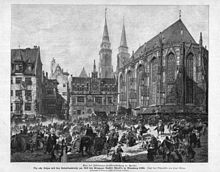Paul Ritter (painter, 1829)
Paul Ritter (born March 4, 1829 in Nuremberg ; † November 27, 1907 ibid) was a German painter and student of Carl Alexander Heideloff .
Life
At the age of four, Paul Ritter became deaf due to illness . He attended the school for the deaf and mute under the direction of Michael Völkel in Nuremberg. He studied painting and graphics at the Nuremberg School of Applied Arts and traveled to France, Italy, Denmark and Austria.
Ritter became known in particular for his large-format architectural images of old Nuremberg with historical figures against the background of the historically faithful architecture of the old town. His best-known pictures in the Nuremberg collection include the old show in Nuremberg with the reception by Gustav Adolf in 1632, the beautiful fountain in 1632 , the introduction of the imperial regalia in Nuremberg in 1424 and the white tower with its surroundings .
He worked closely with his brother Lorenz Ritter (1832–1921) throughout his life . In 1888, Paul Ritter was appointed Royal Professor by Prince Regent Luitpold of Bavaria . With the help of his brother, he taught at the Nuremberg School of Applied Arts .
Paul Ritter is considered the most important architectural painter of German historicism. On the 100th anniversary of the death, he was in the autumn of 2007 by the Painting and Sculpture Collection of the City Museums honored with a major exhibition.
Paul Ritter remained unmarried and had no offspring. However, he maintained a close relationship with his brother Lorenz and his children. In 1870 Paul Ritter founded a deaf and dumb club in Nuremberg, where he was the first director. The association existed until it was dissolved in 1879 (excerpt from the newspaper Taubstummenfreund , 1883). In 1907 he was raised as an honorary member of the deaf and dumb society "Horseshoe" for handicraft and art in Munich.
He was buried on November 29, 1907 in the Nuremberg Johannisfriedhof, where his grave (St. Johannis IE / 145) is still to this day. In Nuremberg- Eberhardshof , the Paul-Ritter-Schule of the center for the hearing impaired of the administrative region Middle Franconia was named after him.
literature
- Ursula Kubach-Reutter (Ed.): Late Romanticism in the Industrial Age. The Nuremberg artist family Ritter. (Exhibition catalog of the collection of paintings and sculptures of the Nuremberg Museums in the Museum for Industrial Culture, September 28 to December 2, 2007), Nuremberg Museums, Nuremberg 2007.
- Silke Colditz-Heusl: Paul Ritter and the cultural and historical cityscape of Nuremberg in the late 19th century. In memoriam Manfred H. Grieb * 1933 - † 2012. Nuremberg patron, Norica collector (= Nuremberg workpieces for city and state history, 73). Edited by the Nuremberg City Archives, Schmidt, Neustadt an der Aisch, 2013, ISBN 978-3-87707-889-1 (= also dissertation at the University of Erlangen-Nuremberg, 2012).
Web links
- Late Romanticism in the Industrial Age: The Nuremberg artist family Ritter. In: nuernberg.de. 2007(Ritter exhibition in the Museum of Industrial Culture in the City of Nuremberg).
- Franziska Fehringer, Markus Beetz: Paul Ritter the Elder. In: Monacensia Signing History, Munich. November 29, 2005 .
Individual evidence
- ↑ Ursula Kubach-Reutter (Ed.): Late Romanticism in the Industrial Age. The Nuremberg artist family Ritter. Nuremberg 2007, p. 148.
-
↑ Paul-Ritter-Schule Support Center Supporting Focus Hearing. In: zentrum-fuer-hoergeschaedigte.de. Retrieved February 3, 2017 . Paul-Ritter-School. In: nuernberg.de. Retrieved February 3, 2017 .
| personal data | |
|---|---|
| SURNAME | Knight, Paul |
| ALTERNATIVE NAMES | Ritter, Johann Paul the Elder |
| BRIEF DESCRIPTION | German painter |
| DATE OF BIRTH | March 4, 1829 |
| PLACE OF BIRTH | Nuremberg |
| DATE OF DEATH | November 27, 1907 |
| Place of death | Nuremberg |

